Rapid Exploration Using pXRF Combined with Geological Connotation Method (GCM): A Case Study of the Nuocang Cu Polymetallic District, Tibet
Abstract
:1. Introduction
2. Deposit Geology and Structure
3. pXRF
3.1. Instrument Principle
3.2. QA/QC
3.2.1. Accuracy and Precision
3.2.2. Stability
4. Discussion
4.1. Enrichment Granularity
4.2. Principal Component Analysis
4.3. Denudation Degree
5. Geological Connotation Method (GCM)
6. Conclusions
- Using a pXRF to carry out large-scale soil geochemical exploration can greatly shorten the abnormal verification time while ensuring high accuracy and precision. This method ensures the continuity and stability of field work and meets the needs of primary and secondary halo geochemical exploration. However, due to its high limit of detection, it is not suitable for small-scale geochemical exploration such as the RGNR (Regional Geochemistry-National Reconnaissance Program).
- We suggest combining the pXRF with the geological connotation method, which can ensure the anomalies related to mineralization are highlighted and avoid interference. This method can make full use of the massive element data of the pXRF to highlight “weak” and “small” anomalies. The area and location of secondary halos are different for different elements, which undoubtedly increases the multi-solution of geochemical exploration. Therefore, when we focus on the element combination of a certain metallogenic type or an area with the highest metallogenic intensity, we do not have to waste time comparing the anomalies of each element.
- It is not appropriate to obtain a lot of data below the limit of detection, so it is necessary to conduct a grain size test before sampling. The best sampling granularity in Nuocang is −10~+60 mesh, which can be used as a reference for the same formation in western Gangdese.
- Before trenching, we recommend investigating the denudation degree in advance, so as not to only find oxidized or low-grade orebodies. The copper–lead–zinc orebodies produced in the rhyolite porphyry of the Dianzhong Formation were successfully uncapped using trenches, indicating that the main types of the deposit are closely related to volcanic activity. Central Nuocang should have the prospecting potential of epithermal deposits, and future studies can be arranged accordingly.
Supplementary Materials
Author Contributions
Funding
Data Availability Statement
Acknowledgments
Conflicts of Interest
References
- Mao, J.; Pirajno, F.; Lehmann, B.; Luo, M.; Berzina, A. Distribution of porphyry deposits in the Eurasian continent and their corresponding tectonic settings. J. Asian Earth Sci. 2014, 79, 576–584. [Google Scholar] [CrossRef]
- Wu, S.; Zheng, Y.; Wang, D.; Chang, H.; Tan, M. Variation of copper isotopes in chalcopyrite from Dabu porphyry Cu-Mo deposit in Tibet and implications for mineral exploration. Ore Geol. Rev. 2017, 90, 14–24. [Google Scholar] [CrossRef]
- Zheng, Y.; Sun, X.; Gao, S.; Wu, S.; Xu, J.; Jiang, J.; Chen, X.; Zhao, Z.; Liu, Y. Metallogenesis and the minerogenetic series in the Gangdese polymetallic copper belt. J. Asian Earth Sci. 2015, 103, 23–39. [Google Scholar] [CrossRef]
- Wu, S.; Zheng, Y.; Sun, X. Subduction metasomatism and collision-related metamorphic dehydration controls on the fertility of porphyry copper ore-forming high Sr/Y magma in Tibet. Ore Geol. Rev. 2016, 73, 83–103. [Google Scholar] [CrossRef]
- Wu, S.; Zheng, Y.; Xu, B.; Jiang, G.; Yi, J.; Liu, X.; Zheng, S.; Li, L. Heterogeneous mantle associated with asthenosphere and Indian slab metasomatism: Constraints on fertilization of porphyry Cu mineralization in Tibetan orogen. Ore Geol. Rev. 2022, 140. [Google Scholar] [CrossRef]
- Yang, Z.; Hou, Z.; White, N.C.; Chang, Z.; Li, Z.; Song, Y. Geology of the post-collisional porphyry copper–molybdenum deposit at Qulong, Tibet. Ore Geol. Rev. 2009, 36, 133–159. [Google Scholar] [CrossRef]
- Tang, J.X.; Wang, D.H.; Wang, X.W.; Zhong, K.H.; Ying, L.J.; Zheng, W.B.; Li, F.G.; Guo, N.; Qin, Z.P. Geological features and metallogenic model of the Jiama copper-polymetallic deposit in Tibet. Diqiu Xuebao (Acta Geosci. Sin.) 2010, 31, 495–506. (In Chinese) [Google Scholar]
- Xu, B.; Hou, Z.; Zheng, Y.; Wang, R.; He, M.; Zhou, L.; Wang, Z.; He, W.; Zhou, Y.; Yang, Y. In situ elemental and isotopic study of diorite intrusions: Implication for Jurassic arc magmatism and porphyry Cu-Au mineralisation in southern Tibet. Ore Geol. Rev. 2017, 90, 1063–1077. [Google Scholar] [CrossRef]
- Zheng, Y.; Ci, Q.; Gao, S.; Wu, S.; Jiang, X.; Chen, X. The Ag-Sn-Cu polymetallic minerogenetic series and prospecting direction in the western Gangdese belt, Tibet. Earth Sci. Front. 2021, 28, 379–402. (In Chinese) [Google Scholar] [CrossRef]
- Lemière, B. A review of pXRF (field portable X-ray fluorescence) applications for applied geochemistry. J. Geochem. Explor. 2018, 188, 350–363. [Google Scholar] [CrossRef] [Green Version]
- Ge, L.; Lai, W.; Zhou, S.; Xie, T.; Zhang, Y. X radiation sampling technique for in situ rapid determination of ore grade. Met. Mine 1997, 26, 12–17. (In Chinese) [Google Scholar]
- Zhang, Y.; Xie, T.; Zhou, S.; Ge, L.; Lai, W. A study of X-ray fluorescence technique in the in situ prospecting for gold deposits in Shandong area. Geophys. Geochem. Explor. 1990, 14, 69–72. (In Chinese) [Google Scholar]
- Lemière, B.; Melleton, J.; Auger, P.; Derycke, V.; Gloaguen, E.; Bouat, L.; Mikšová, D.; Filzmoser, P.; Middleton, M. pXRF measurements on soil samples for the exploration of an antimony deposit: Example from the Vendean Antimony District (France). Minerals 2020, 10, 724. [Google Scholar] [CrossRef]
- Han, Z.; Wang, R.; Tong, X.; Sun, F.; Li, Y.; Liu, S.; Xue, Q. Multi-scale exploration of giant Qulong porphyry deposit in a collisional setting. Ore Geol. Rev. 2021, 139, 104455. [Google Scholar] [CrossRef]
- Bosco, G.L. Development and application of portable, hand-held X-ray fluorescence spectrometers. TrAC Trends Anal. Chem. 2013, 45, 121–134. [Google Scholar] [CrossRef]
- Gray, C.; Van Rythoven, A. A comparative study of porphyry-type copper deposit mineralogies by portable X-ray fluorescence and optical petrography. Minerals 2020, 10, 431. [Google Scholar] [CrossRef]
- Balaram, V.; Sawant, S.S. Indicator minerals, pathfinder elements, and portable analytical instruments in mineral exploration studies. Minerals 2022, 12, 394. [Google Scholar] [CrossRef]
- Wang, C. Basics of Exploration Geochemistry; Geological Publishing House: Beijing, China, 1987. (In Chinese) [Google Scholar]
- Iwamori, H.; Yoshida, K.; Nakamura, H.; Kuwatani, T.; Hamada, M.; Haraguchi, S.; Ueki, K. Classification of geochemical data based on multivariate statistical analyses: Complementary roles of cluster, principal component, and independent component analyses. Geochem. Geophys. Geosyst. 2017, 18, 994–1012. [Google Scholar] [CrossRef]
- Heidarian, H.; Lentz, D.R.; Thorne, K.; Rogers, N. Application of portable X-ray and micro-X-ray fluorescence spectrometry to characterize alteration and mineralization within various gold deposits hosted in southern New Brunswick, Canada. J. Geochem. Explor. 2021, 229, 106847. [Google Scholar] [CrossRef]
- Aitchison, J. The statistical analysis of compositional data. J. R. Stat. Soc. Ser. B (Methodol.) 1986, 44, 139–177. [Google Scholar] [CrossRef]
- Jiang, X.; Chen, X.; Zheng, Y.; Gao, S.; Ouyang, S.; Zhang, Y.; Zheng, L.; Huang, J. The recognition and extraction of Au, Cu geochemical composite anomalies: A case study of the east of Laji Mountains. Geophys. Geochem. Explor. 2017, 41, 459–467. (In Chinese) [Google Scholar] [CrossRef]
- Jiang, X.; Chen, X.; Gao, S.; Zheng, Y.; Ren, H.; Han, D.; Yan, C.; Jiang, J. A new discovery of Ag-Pb-Zn mineralization via modern portable analytical technology and stream sediment data processing methods in Dajiacuo area, western Tibet (China). J. Earth Sci. 2020, 31, 668–682. [Google Scholar] [CrossRef]
- Nesbitt, H.W.; Young, G.M. Early Proterozoic climates and plate motions inferred from major element chemistry of lutites. Nature 1982, 299, 715–717. [Google Scholar] [CrossRef]
- Harnois, L. The CIW index: A new chemical index of weathering. Sediment. Geol. 1988, 55, 319–322. [Google Scholar] [CrossRef]
- Parker, A. An index of weathering for silicate rocks. Geol. Mag. 1970, 107, 501–504. [Google Scholar] [CrossRef]
- Li, S.; Jiao, X.; Hao, H.; Han, T.; Sun, Z.; Li, B.; Li, Z.; Xing, H.; Han, Y. An analysis of the denudation degree of Pb-Zn-Ag polymetallic deposits in the north of Zhangjiakou area. Diqiu Xuebao (Acta Geosci. Sin.) 2021, 42, 537–544. (In Chinese) [Google Scholar]
- Gong, Q.; Deng, J.; Wang, C.; Wang, Z.; Zhou, L. Element behaviors due to rock weathering and its implication to geochemical anomaly recognition: A case study on Linglong biotite granite in Jiaodong peninsula, China. J. Geochem. Explor. 2013, 128, 14–24. [Google Scholar] [CrossRef]
- Shao, Y. Research on primary zoning of ore deposits and its application in geochemical prospecting. Geol. Prospect. 1984, 2, 47–55. [Google Scholar]
- Kimura, H.; Watanabe, Y. Oceanic anoxia at the Precambrian-Cambrian boundary. Geol. Prospect. 2001, 29, 995–998. [Google Scholar] [CrossRef]
- Cheng, Q.; Agterberg, F.P.; Ballantyne, S.B. The separation of geochemical anomalies from background by fractal methods. J. Geochem. Explor. 1994, 51, 109–130. [Google Scholar] [CrossRef]
- Cheng, Q.; Xu, Y.; Grunsky, E. Integrated spatial and spectrum method for geochemical anomaly separation. Nat. Resour. Res. 2000, 9, 43–52. [Google Scholar] [CrossRef]
- Tian, L. Geochemical Data Processing and Targets Optimization in Eastern Kunlun Orogenic Belt, Qinghai Province, China; China University of Geosciences: Wuhan, China, 2017. (In Chinese) [Google Scholar]
- Zheng, Y.; Gao, S.; Xue, Z.; Sun, X.; Zheng, H.; Ke, Z.; Liu, M. A Method for Identifying and Evaluating Anomalies in Geochemical Exploration Based on Geological Connotation. CN Patent 103345566A, 9 October 2013. (In Chinese). [Google Scholar]
- Zheng, Y.; Chen, R.; Pang, Y.; Shi, J.; Gao, S.; Zuo, R.; Xie, Y. Metallogenic prediction method: Theoretical exploration and practice. Earth Sci. 2009, 34, 511–524. (In Chinese) [Google Scholar]
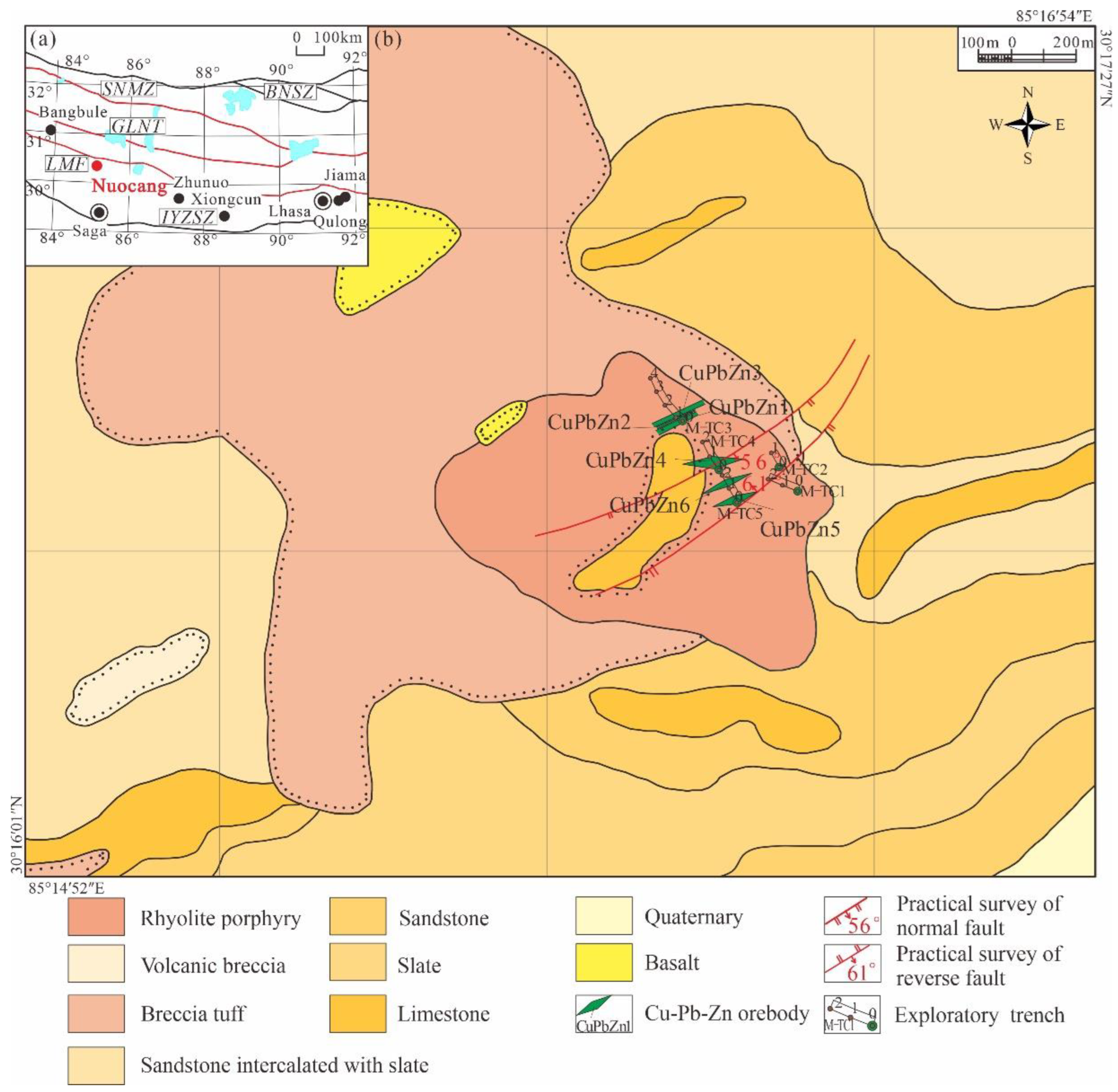
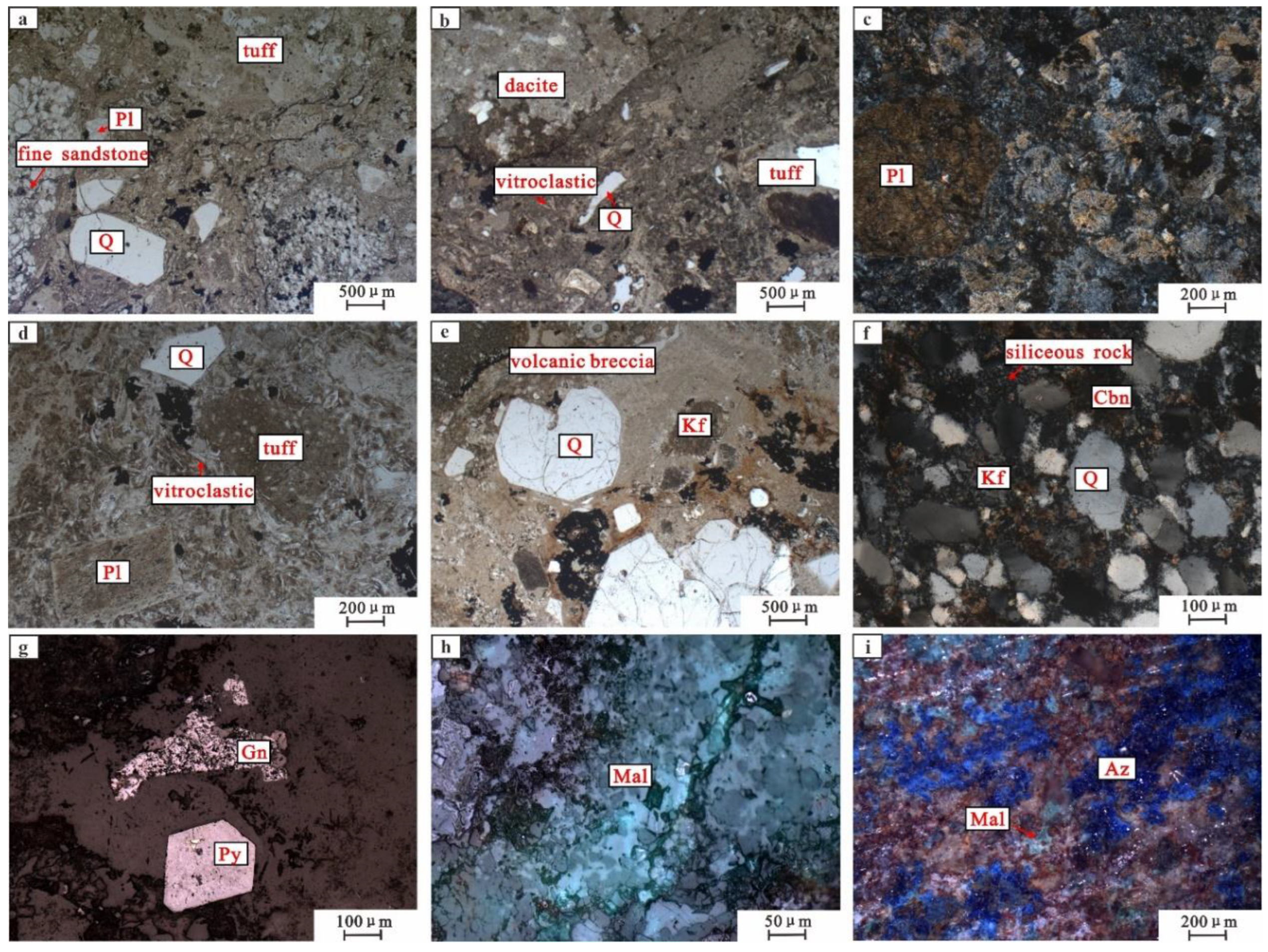
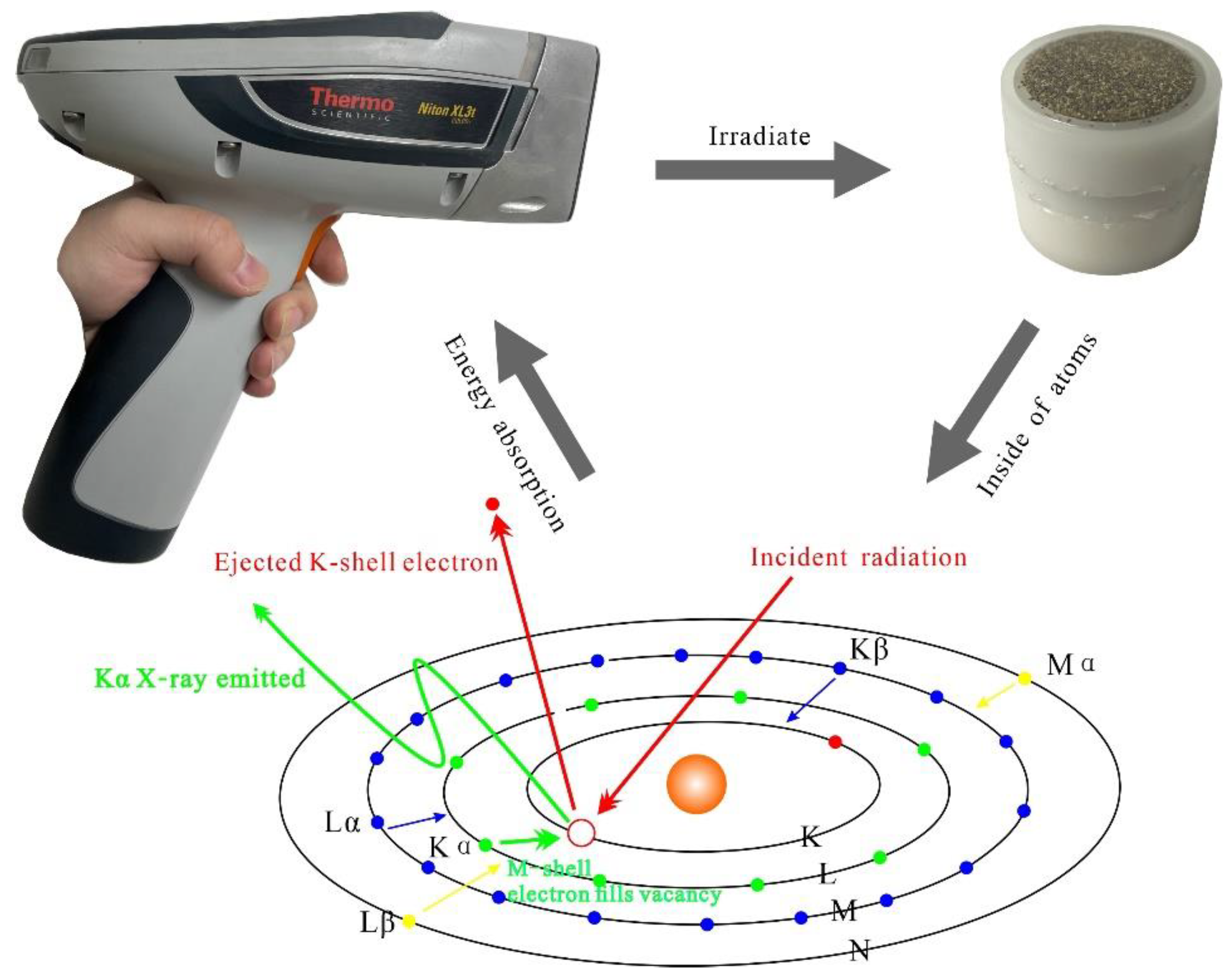
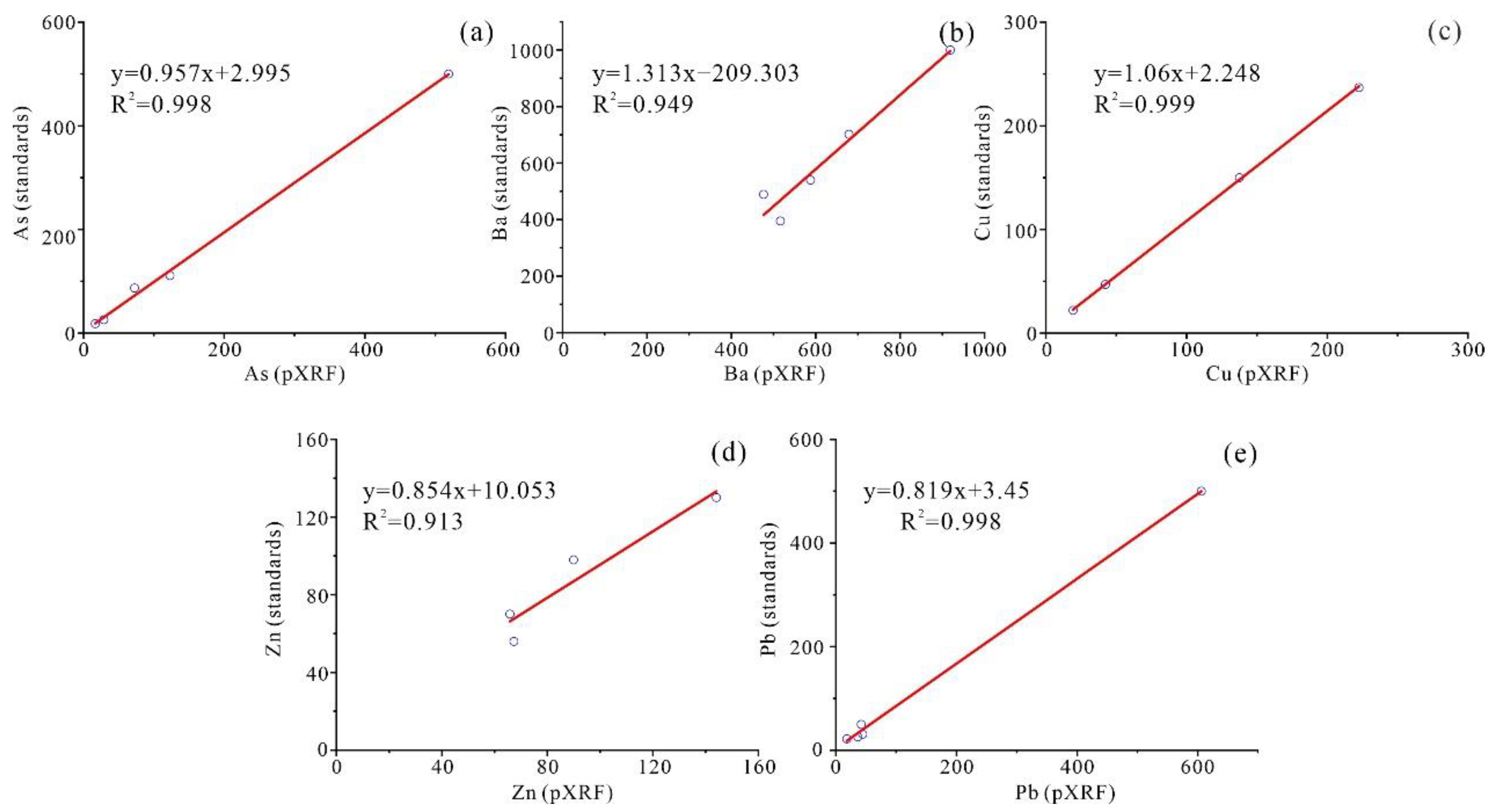
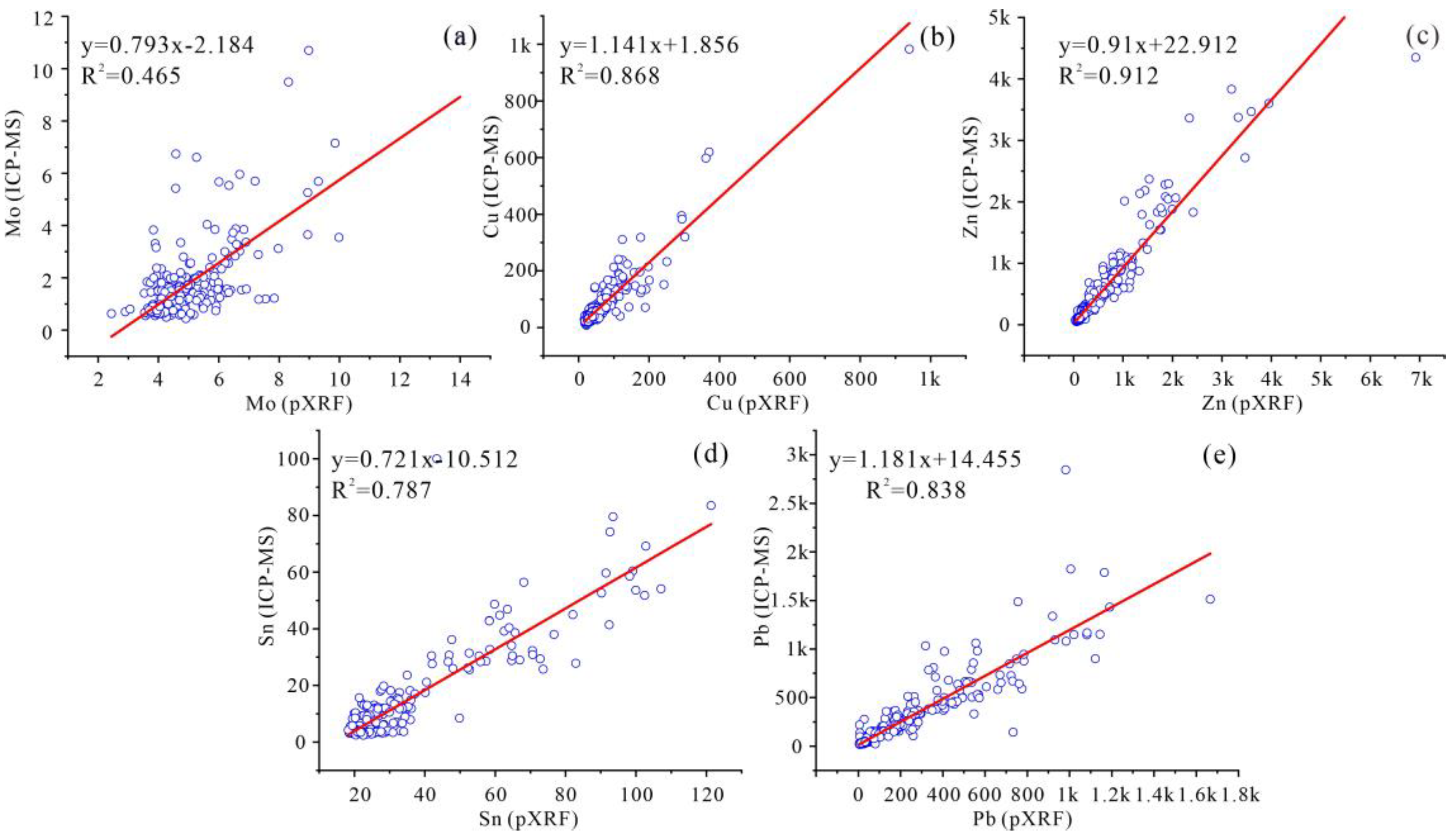
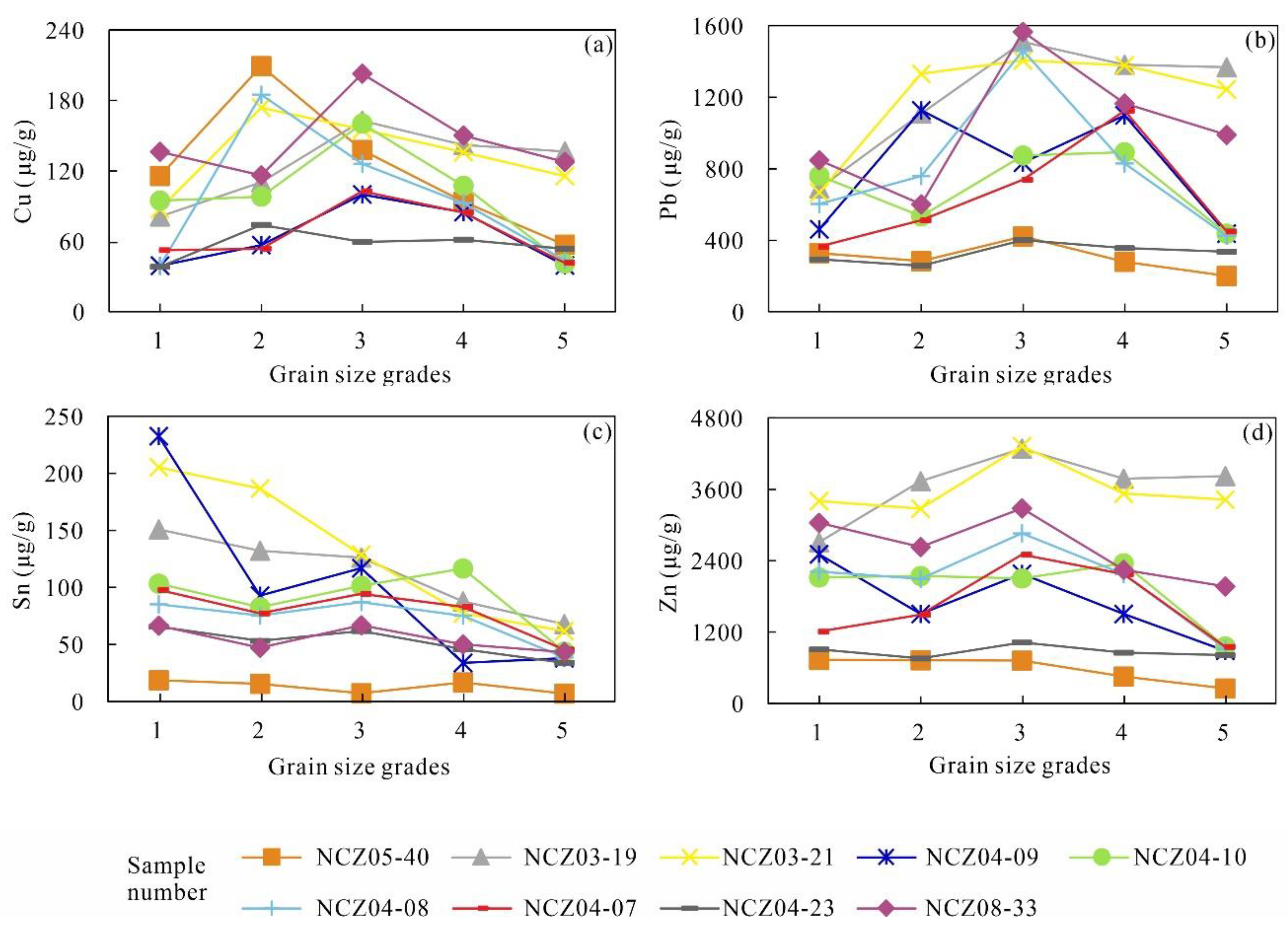
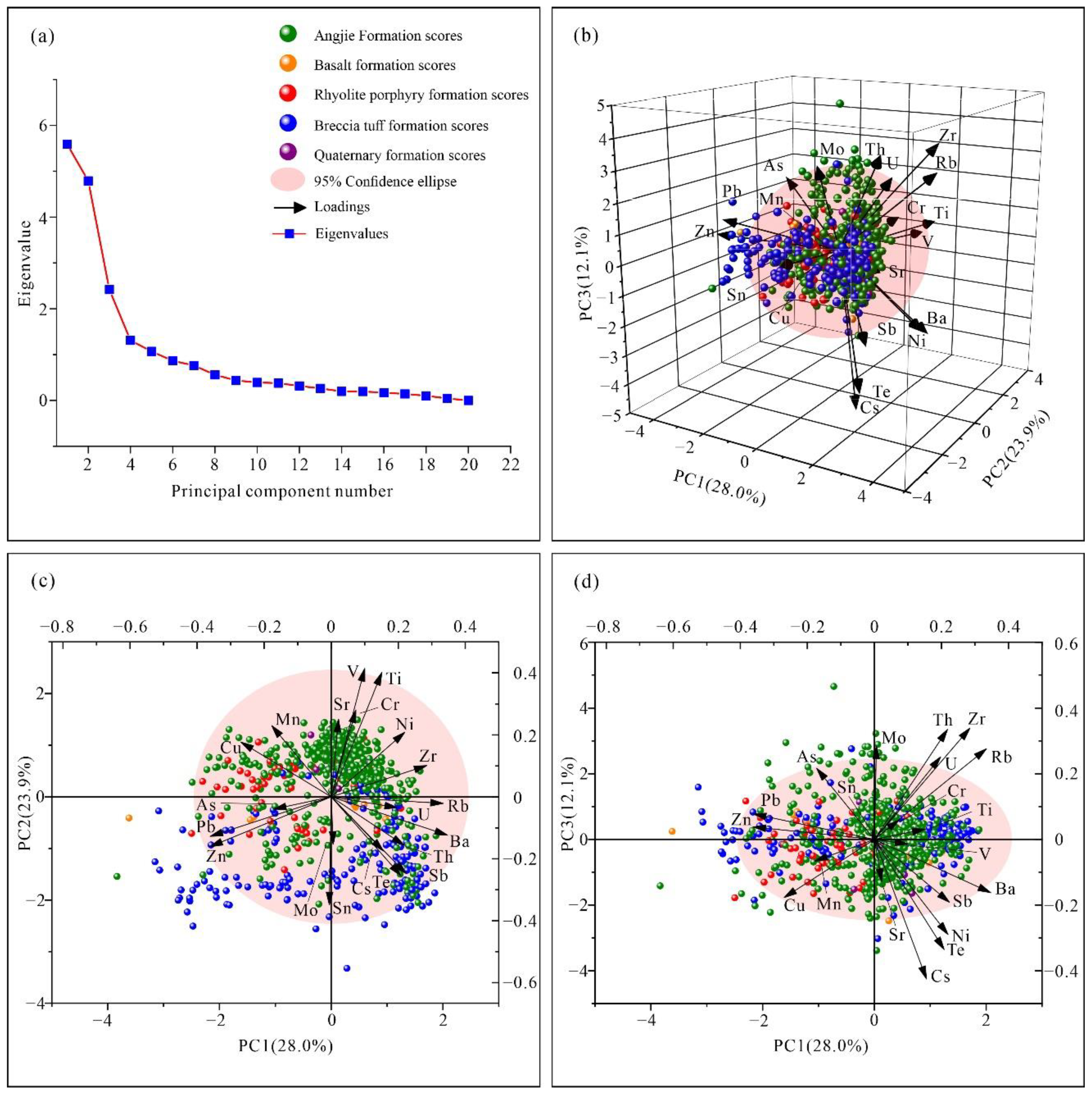

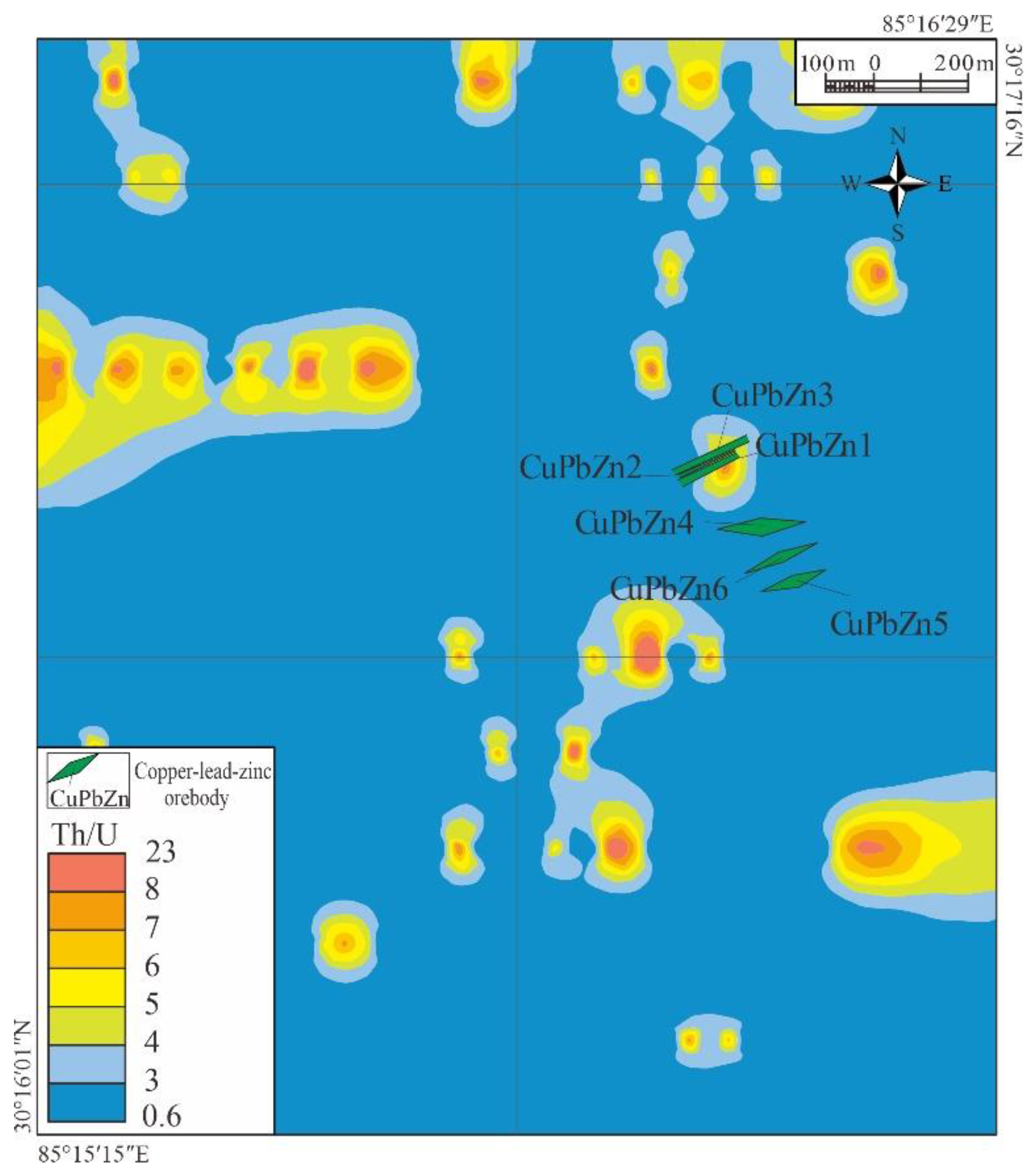

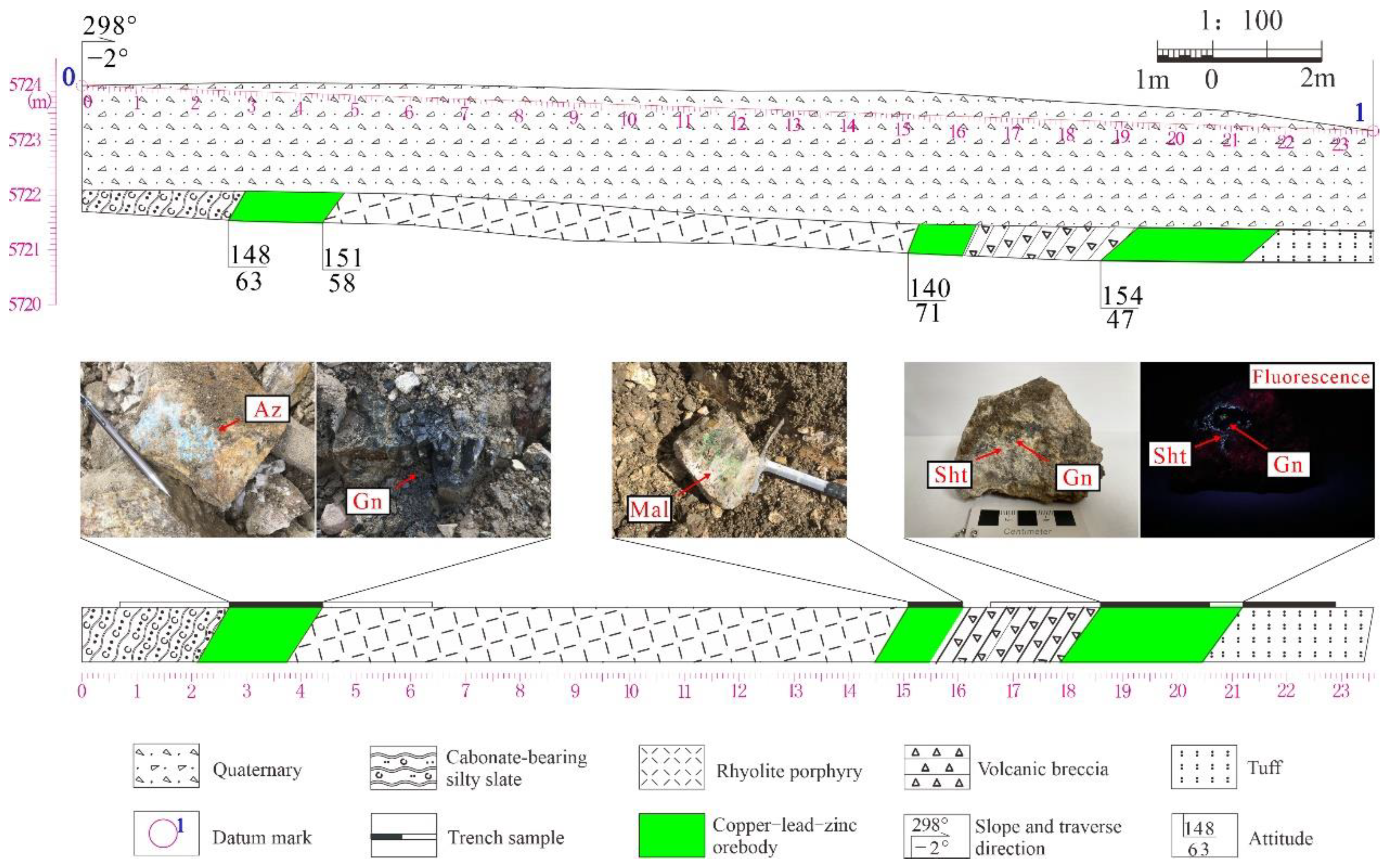
| Elements | Zr | Sr | Rb | Pb | As | Zn | W | Cu | Mn | Ti |
|---|---|---|---|---|---|---|---|---|---|---|
| TILL-4 | 385 | 109 | 161 | 50 | 111 | 70 | 204 | 237 | 490 | 4840 |
| pXRF | 400.54 | 101.48 | 174.44 | 41.97 | 120.56 | 65.7 | 176.31 | 223.03 | 510.62 | 4905.94 |
| 0.017 | 0.031 | 0.035 | 0.076 | 0.036 | 0.028 | 0.063 | 0.026 | 0.035 | 0.006 | |
| RSD | 4.30% | 7.38% | 8.85% | 7.85% | 9.54% | 9.22% | 15.92% | 8.42% | 8.83% | 1.77% |
| Sample Number | Relative Deviation (RD)/% | ||||||||||
|---|---|---|---|---|---|---|---|---|---|---|---|
| Zr | Sr | Rb | Th | Pb | As | Zn | Cu | Mn | Ti | Sn | |
| NCZ02-05C | 0.11 | 0.36 | 1.36 | 8.24 | 0.35 | 1.56 | 1.87 | 5.08 | 0.58 | 0.33 | <LOD * |
| NCZ03-14C | 0.65 | 0.47 | 0.21 | 3.62 | 0.39 | 3.73 | 0.73 | 8.48 | 0.70 | 1.10 | 0.03 |
| NCZ04-19C | 0.74 | 1.77 | 1.28 | 1.18 | <LOD | <LOD | 0.77 | <LOD | 2.80 | 0.20 | <LOD |
| NCZ07-10C | 0.92 | 0.35 | 0.03 | 2.60 | <LOD | 2.98 | 0.58 | <LOD | 2.06 | 1.64 | 0.13 |
| NCZ08-14C | 0.86 | 0.03 | 0.18 | 8.15 | 5.71 | 10.57 | 5.11 | <LOD | 0.52 | 0.31 | 0.05 |
| NCZ09-18C | 20.15 | 20.16 | 19.39 | 16.20 | 20.38 | 14.17 | 22.40 | <LOD | 19.55 | 1.04 | 0.15 |
| NCZ10-22C | 0.16 | 0.21 | 0.17 | 0.34 | 4.60 | 11.66 | 1.34 | 7.36 | 0.24 | 0.15 | <LOD |
| NCZ11-26C | 0.29 | 0.33 | 0.50 | 3.64 | 2.56 | 1.84 | 0.16 | <LOD | 0.92 | 0.19 | <LOD |
| NCZ12-30C | 0.13 | 0.61 | 0.13 | 1.38 | 1.53 | 2.45 | 2.00 | 4.25 | 2.91 | 0.18 | <LOD |
| NCZ14-02C | 0.46 | 0.51 | 0.34 | 4.57 | 0.55 | 2.55 | 0.41 | 6.29 | 0.46 | 0.47 | <LOD |
| NCZ15-13C | 0.56 | 0.79 | 0.81 | 0.68 | 8.91 | 3.18 | 3.86 | <LOD | 2.49 | 0.48 | 0.05 |
| NCZ16-24C | 0.72 | 0.12 | 0.26 | 2.48 | <LOD | 8.94 | 4.51 | 3.85 | 1.78 | 0.18 | 0.05 |
| NCZ17-35C | 0.38 | 1.54 | 0.76 | 5.73 | 0.58 | 8.73 | 0.27 | 4.39 | 0.39 | 0.08 | 0.09 |
| NCZ19-07C | 0.50 | 0.17 | 0.60 | 8.94 | <LOD | <LOD | 5.07 | 4.46 | 0.09 | 0.27 | <LOD |
| NCZ19-39C | 0.28 | 0.62 | 0.23 | 0.49 | 0.87 | 0.28 | 0.30 | 14.01 | 0.57 | 0.22 | 0.01 |
| NCZ10-13C | 0.49 | 0.03 | 1.07 | 0.32 | 1.26 | 0.43 | 1.58 | <LOD | 0.55 | 0.32 | <LOD |
| NCZ11-09C | 0.04 | 0.83 | 0.13 | 1.12 | 0.10 | 7.83 | 2.43 | 3.31 | 0.57 | 0.58 | <LOD |
| NCZ12-14C | 19.64 | 20.40 | 19.73 | 16.76 | 29.81 | 11.93 | 20.05 | 14.81 | 20.31 | 0.32 | <LOD |
| NCZ13-32C | 0.23 | 0.77 | 0.34 | 4.06 | 0.77 | 0.25 | 0.81 | 3.02 | 1.23 | 0.51 | <LOD |
| NCZ15-05C | 1.19 | 0.04 | 1.10 | 0.53 | 2.60 | 0.78 | 5.74 | 1.25 | 1.11 | 0.62 | <LOD |
| NCZ16-25C | 0.66 | 0.14 | 1.00 | 10.50 | 17.19 | 3.66 | 3.02 | <LOD | 1.24 | 0.11 | <LOD |
| NCZ18-11C | 0.31 | 0.42 | 0.14 | 7.16 | 0.04 | 1.05 | 0.71 | 0.09 | 0.21 | 0.07 | <LOD |
| Qualification rate | 100 | 100 | 100 | 100 | 95.45 | 100 | 100 | 100 | 100 | 100 | 100 |
| Component | Mo | Zr | Sr | U | Rb | Th | Pb | As | Zn | Cu |
|---|---|---|---|---|---|---|---|---|---|---|
| PC1 | 0.006 | 0.285 | 0.022 | 0.198 | 0.334 | 0.218 | −0.361 | −0.172 | −0.362 | −0.269 |
| PC2 | −0.153 | 0.101 | 0.251 | −0.035 | −0.021 | −0.156 | −0.128 | −0.04 | −0.161 | 0.177 |
| PC3 | 0.285 | 0.339 | −0.128 | 0.251 | 0.276 | 0.335 | 0.078 | 0.216 | 0.038 | −0.177 |
| Component | Ni | Mn | Cr | V | Ti | Ba | Cs | Te | Sb | Sn |
| PC1 | 0.22 | −0.178 | 0.074 | 0.1 | 0.151 | 0.347 | 0.155 | 0.208 | 0.224 | −0.005 |
| PC2 | 0.209 | 0.23 | 0.281 | 0.414 | 0.401 | −0.124 | −0.175 | −0.255 | −0.248 | −0.349 |
| PC3 | −0.29 | −0.066 | 0.059 | −0.014 | 0.031 | −0.162 | −0.425 | −0.336 | −0.191 | 0.03 |
Publisher’s Note: MDPI stays neutral with regard to jurisdictional claims in published maps and institutional affiliations. |
© 2022 by the authors. Licensee MDPI, Basel, Switzerland. This article is an open access article distributed under the terms and conditions of the Creative Commons Attribution (CC BY) license (https://creativecommons.org/licenses/by/4.0/).
Share and Cite
Pang, B.; Wu, S.; Yu, Z.; Liu, Y.; Li, J.; Zheng, L.; Chen, H.; Li, X.; Shi, G. Rapid Exploration Using pXRF Combined with Geological Connotation Method (GCM): A Case Study of the Nuocang Cu Polymetallic District, Tibet. Minerals 2022, 12, 514. https://doi.org/10.3390/min12050514
Pang B, Wu S, Yu Z, Liu Y, Li J, Zheng L, Chen H, Li X, Shi G. Rapid Exploration Using pXRF Combined with Geological Connotation Method (GCM): A Case Study of the Nuocang Cu Polymetallic District, Tibet. Minerals. 2022; 12(5):514. https://doi.org/10.3390/min12050514
Chicago/Turabian StylePang, Bei, Song Wu, Zezhang Yu, Yu Liu, Jianbing Li, Lei Zheng, Hao Chen, Xiaoxia Li, and Gongwen Shi. 2022. "Rapid Exploration Using pXRF Combined with Geological Connotation Method (GCM): A Case Study of the Nuocang Cu Polymetallic District, Tibet" Minerals 12, no. 5: 514. https://doi.org/10.3390/min12050514
APA StylePang, B., Wu, S., Yu, Z., Liu, Y., Li, J., Zheng, L., Chen, H., Li, X., & Shi, G. (2022). Rapid Exploration Using pXRF Combined with Geological Connotation Method (GCM): A Case Study of the Nuocang Cu Polymetallic District, Tibet. Minerals, 12(5), 514. https://doi.org/10.3390/min12050514






